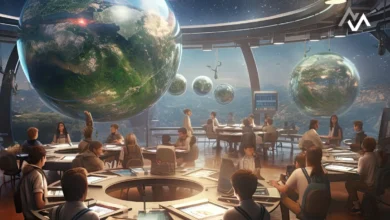A Wake-Up Call from Prehistoric Times: Lessons for Our Future

The Earth’s history is a long, complex tale, punctuated by periods of massive change, both gradual and catastrophic. Recently, scientists studying ancient events from a time before the dinosaurs were astonished to uncover patterns of environmental upheaval that bear a striking resemblance to what we face today. These discoveries serve as a sobering wake-up call, offering us a glimpse into Earth’s distant past while providing valuable lessons about our planet’s future.
What can we learn from the times before dinosaurs? What warning signs are we seeing today that mirror these ancient shifts, and how can we, as a society, act on this knowledge to prevent further damage? In this article, we will explore the parallels between these ancient geological events and the current environmental challenges we face.
1. The Prehistoric Extinction Event: A Window to the Future
Approximately 252 million years ago, the Earth experienced the Permian-Triassic extinction event, which wiped out nearly 90% of all marine species and 70% of land species. This catastrophic event, caused by extreme volcanic activity, led to significant global warming, acidification of the oceans, and depletion of oxygen. The event is now referred to as “The Great Dying.”
Why does this matter to us today? Because we are once again witnessing significant environmental shifts—this time caused by human activity. Rising global temperatures, widespread deforestation, ocean acidification, and increasing levels of carbon dioxide are eerily reminiscent of the conditions that led to the mass extinction millions of years ago.
2. Climate Change: History Repeats Itself
The study of past extinction events shows us how sensitive Earth’s systems are to disruptions. Today, we are witnessing accelerated climate change, fueled primarily by industrial activities and the relentless consumption of fossil fuels. Glaciers are melting at an unprecedented rate, sea levels are rising, and extreme weather events are becoming the norm.
Much like the ancient event, where a sharp increase in greenhouse gases led to global warming, our carbon emissions are pushing the Earth’s systems to their limits. While the Permian extinction was caused by natural forces, we are driving similar changes through human-induced environmental damage.
Understanding the Earth’s past teaches us that these changes have long-lasting, potentially irreversible consequences. Without urgent action, we risk creating a future that mirrors this ancient catastrophe.
3. The Fragile Balance of Ecosystems
Ecosystems are intricate webs of life, finely balanced and highly sensitive to even slight changes in temperature, air quality, and other environmental factors. The Permian extinction showed how vulnerable ecosystems are to collapse when stressed by sudden changes.
Today, we are seeing biodiversity decline at alarming rates. Species are disappearing 100 to 1,000 times faster than the natural extinction rate, mainly due to habitat destruction, pollution, and overexploitation. This erosion of biodiversity weakens the resilience of ecosystems, leaving them vulnerable to collapse, much like during the Great Dying.
To safeguard the planet, we must prioritize the protection and restoration of ecosystems. Ensuring the survival of diverse species is essential for maintaining the stability and health of our planet.
4. The Role of Human Action in Preventing Future Disasters
The parallels between the Permian extinction and our current environmental crisis are undeniable. But unlike ancient species, humans have the unique ability to recognize these warning signs and change the course of history.
Transitioning to renewable energy, reducing carbon emissions, protecting natural habitats, and adopting sustainable lifestyles are crucial steps in reversing the damage. The choices we make today will determine the future of life on Earth.
Leaders, governments, and individuals must collaborate globally to implement policies that mitigate climate change and protect the planet. Collective action is essential to avoid repeating the catastrophic events of Earth’s prehistoric past.
5. The Need for Global Awareness and Action
The findings from Earth’s distant past serve as a stark reminder that we are part of a much larger, interconnected system. When we disrupt the balance, the consequences are profound, as history has shown us. However, with global awareness and concerted action, we can prevent the worst effects of climate change and environmental degradation.
This wake-up call from prehistoric times is one we cannot afford to ignore. The window for action is closing fast, but the solutions are within our reach. By learning from Earth’s ancient past, we can build a future that avoids the mistakes of history and ensures a livable planet for future generations.
Conclusion: A Call to Heed Nature’s Lessons
The Permian-Triassic extinction teaches us that our planet’s systems are fragile and can be pushed to the brink of collapse. While our current environmental crisis may feel overwhelming, the lessons of the past give us a clear path forward: we must act decisively, protect ecosystems, reduce carbon emissions, and transition to a more sustainable way of life.
As history repeats itself, we must make sure the outcome is different this time. Let this be our wake-up call to take responsibility for the planet we all share




